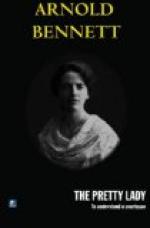There was a soft knock; the door was pushed, and wavy reflections of the drawing-room fire played on the corner of the bedroom ceiling. Mrs. Braiding came in. G.J. had known it was she by the caressing quality of the knock. Mrs. Braiding was his cook and the wife of his “man”. It was not her place to come in, but occasionally, because something had happened to Braiding, she did come in. She drew the curtains apart, and the day of Vigo Street, pale, dirty, morose, feebly and perfunctorily took possession of the bedroom. Mrs. Braiding, having drawn the curtains, returned to the door and from the doorway said:
“Breakfast is practically ready, sir.”
G.J. perceived that this was one of her brave, resigned mornings. Since August she had borne the entire weight of the war on her back, and sometimes the burden would overpower her, but never quite. G.J. switched on the light, arose from his bed, assumed his dressing-gown, and, gazing with accustomed pleasure round the bedroom, saw that it was perfect.
He had furnished his flat in the Regency style of the first decade of the nineteenth century, as matured by George Smith, “upholder extraordinary to His Royal Highness the Prince of Wales”. The Pavilion at Brighton had given the original idea to G.J., who saw in it the solution of the problem of combining the somewhat massive dignity suitable to a bachelor of middling age with the bright, unconquerable colours which the eternal twilight of London demands.
His dome bed was yellow as to its upper works, with crimson valances above and yellow valances below. The yellow-lined crimson curtains (of course never closed) had green cords and tassels, and the counterpane was yellow. This bed was a modest sample of the careful and uncompromising reconstitution of a period which he had everywhere carried out in his abode.
The drawing-room, with its moulded ceiling and huge recessed window, had presented an admirable field for connoisseurship. Here the clash of rich primary colours, the perpendiculars which began with bronze girls’ heads and ended with bronze girls’ feet or animals’ claws, the vast flat surfaces of furniture, the stiff curves of wood and a drapery, the morbid rage for solidity which would employ a candelabrum weighing five hundredweight to hold a single wax candle, produced a real and imposing effect of style; it was a style debased, a style which was shedding the last graces of French Empire in order soon to appeal to a Victoria determined to be utterly English and good; but it was a style. And G.J. had scamped no detail. Even the pictures were hung with thick tasselled cords of the Regency. The drawing-room was a triumph.
Do not conceive that G.J. had lost his head about furniture and that his notion of paradise was an endless series of second-hand shops. He had an admirable balance; and he held that a man might make a faultless interior for himself and yet not necessarily lose his balance. He resented being called a specialist in furniture. He regarded himself as an amateur of life, and, if a specialist in anything, as a specialist in friendships. Yet he was a solitary man (liking solitude without knowing that he liked it), and in the midst of the perfections which he had created he sometimes gloomily thought: “What in the name of God am I doing on this earth?”




